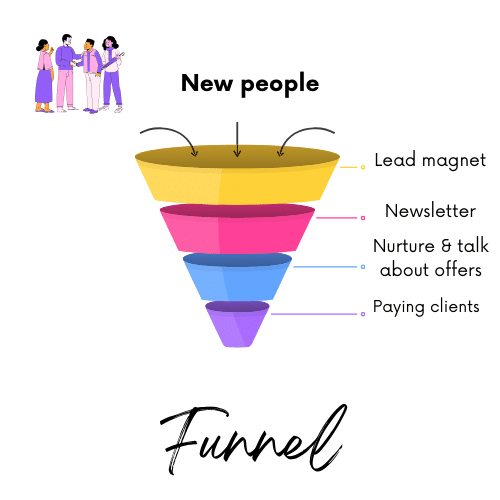A funnel isn’t just for pouring liquids into bottles; it’s also a tool that pours potential customers into your business. Imagine an actual funnel: wide at the top and narrow at the bottom. In business, this represents your potential customers’ journey, from the first time they learn about you to when they purchase (and hopefully become repeat buyers!). This journey is often called the customer or sales funnel; service businesses must understand and optimize it.
How a Sales Funnel for a Service Business Works
Sales funnels aren’t just for those who sell products. Service-based businesses can benefit even more from a well-crafted sales funnel. By understanding their potential client’s needs and pain points, service businesses can strategically guide them through the customer journey, building trust and showcasing their expertise. From the initial lead generation to the final sale, a sales funnel can streamline the process and increase conversions.
The Sales Funnel Journey
As a solopreneur, you might wonder why you can’t just sell directly to anyone who shows up. The truth is, people aren’t ready to buy the moment they meet you. They need to warm up to your brand, understand the value you offer, and trust you enough to open their wallets. A well-designed funnel guides them through this process gently and effectively.
At the top of the funnel, you have a large pool of potential customers who are just becoming aware of your brand. As they move down the funnel, they start engaging with your content, learning more about your products or services, and considering purchasing.

Crafting Your Funnel: Lead Magnets
The first step is to attract people to your funnel. Lead magnets, in combination with landing pages, are a great way to attract potential customers. Think of them as tantalizing appetizers – freebies you offer in exchange for contact information. It could be an ebook, a discount code, or a valuable checklist. Whatever it is, make it so good that your prospects can’t help but bite.
Once they’ve shown interest, it’s time to build that relationship. This is the middle of your funnel, where you provide value, share insights, and engage with your audience. Email sequences, webinars, and informative blog posts are your tools here. The goal is to establish your expertise and show that you understand their needs.
And at the bottom of the funnel, you have a smaller but more committed group of customers ready to convert. But how do you ensure that your funnel is effective and continues to attract and convert potential customers?
The key lies in creating unique and compelling content that speaks directly to your target audience and serves a specific purpose at each funnel stage. Let’s explore how you can do this to create a well-developed piece of content that leaves a lasting impact on your readers.
Social Media & Pinterest: Funnel Amplifiers
Think of social media as the loudspeaker for your funnel. It’s where you can share your lead magnets, connect with your audience, and drive traffic to your funnel. Platforms like Facebook and Instagram let you interact with your community, gather feedback, and keep your brand top-of-mind. (No, your business doesn’t have to be on social media.)
Pinterest might seem like the underdog, but it’s a powerhouse for driving traffic. It’s a visual search engine where users actively seek ideas and solutions. By creating eye-catching pins linked to your lead magnets or content, you tap into a world of potential customers ready to embark on their funnel journey.
Example of a Funnel for a Business Coach
A funnel for a coach might include:
- Building brand awareness on social media
- Capturing leads with an email marketing lead magnet.
- Nurturing those leads through their newsletter.
- Letting them know about their offers through their platform of choice.
- Ultimately converting them into paying clients.
By understanding your target audience and purpose for the content, you can structure each step of the funnel to effectively and authentically connect with your potential clients and guide them towards a successful partnership with your coaching services.
Questions to Ask Yourself
- From beginning to end, think about the main journeys that your customers are making throughout your funnel, which include:
- Traffic Sources (Organic, Ads, Email, etc.): Which ads (if applicable) are shown to the customers at each stage, and how are they finding you organically?
- Landing Pages: Which relevant pages are you sending traffic to get people to act?
- Offers: Which offers are you making to the customer at that stage?
Do You Need a Sales Funnel?
As a solopreneur, your funnel is more than a strategy; it’s the backbone of your business. It helps you understand your customers, build relationships, and ultimately, make sales without spreading yourself too thin. By leveraging lead magnets, social media, and platforms like Pinterest, you can create a funnel that works tirelessly for you – even when you’re off the clock.
Remember, the best funnels are those that evolve. Keep testing, refining, and learning about your audience. Your funnel isn’t just a one-time setup; it’s a dynamic pathway that grows with your business. So keep tweaking, and you’ll find your funnel not only brings in revenue but also brings joy to your entrepreneurial journey.
It’s time to implement an innovative and effective sales funnel strategy for your service-based business. Your bottom line will thank you.


